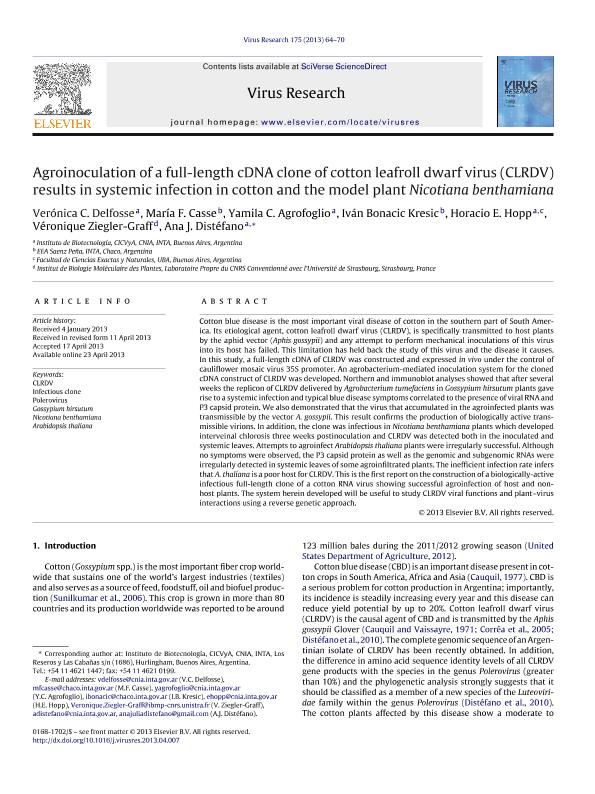Mostrar el registro sencillo del ítem
dc.contributor.author
Delfosse, Verónica Cecilia

dc.contributor.author
Casse, María F.
dc.contributor.author
Agrofoglio, Yamila Carla

dc.contributor.author
Bonacic Kresic , Iván
dc.contributor.author
Hopp, Horacio Esteban

dc.contributor.author
Ziegler Graff, Véronique
dc.contributor.author
Distéfano, Ana Julia

dc.date.available
2017-09-11T21:28:26Z
dc.date.issued
2013-04
dc.identifier.citation
Delfosse, Verónica Cecilia; Casse, María F.; Agrofoglio, Yamila Carla; Bonacic Kresic , Iván; Hopp, Horacio Esteban; et al.; Agroinoculation of a full-length cDNA clone of cotton leafroll dwarf virus (CLRDV) results in systemic infection in cotton and the model plant Nicotiana benthamiana; Elsevier; Virus Research; 175; 1; 4-2013; 64-70
dc.identifier.issn
0168-1702
dc.identifier.uri
http://hdl.handle.net/11336/23959
dc.description.abstract
Cotton blue disease is the most important viral disease of cotton in the southern part of South America. Its etiological agent, cotton leafroll dwarf virus (CLRDV), is specifically transmitted to host plants by the aphid vector (Aphis gossypii) and any attempt to perform mechanical inoculations of this virus into its host has failed. This limitation has held back the study of this virus and the disease it causes. In this study, a full-length cDNA of CLRDV was constructed and expressed in vivo under the control of cauliflower mosaic virus 35S promoter. An agrobacterium-mediated inoculation system for the cloned cDNA construct of CLRDV was developed. Northern and immunoblot analyses showed that after several weeks the replicon of CLRDV delivered by Agrobacterium tumefaciens in Gossypium hirsutum plants gave rise to a systemic infection and typical blue disease symptoms correlated to the presence of viral RNA and P3 capsid protein. We also demonstrated that the virus that accumulated in the agroinfected plants was transmissible by the vector A. gossypii. This result confirms the production of biologically active transmissible virions. In addition, the clone was infectious in Nicotiana benthamiana plants which developed interveinal chlorosis three weeks postinoculation and CLRDV was detected both in the inoculated and systemic leaves. Attempts to agroinfect Arabidopsis thaliana plants were irregularly successful. Although no symptoms were observed, the P3 capsid protein as well as the genomic and subgenomic RNAs were irregularly detected in systemic leaves of some agroinfiltrated plants. The inefficient infection rate infers that A. thaliana is a poor host for CLRDV. This is the first report on the construction of a biologically-active infectious full-length clone of a cotton RNA virus showing successful agroinfection of host and non-host plants. The system herein developed will be useful to study CLRDV viral functions and plant–virus interactions using a reverse genetic approach.
dc.format
application/pdf
dc.language.iso
eng
dc.publisher
Elsevier

dc.rights
info:eu-repo/semantics/openAccess
dc.rights.uri
https://creativecommons.org/licenses/by-nc-sa/2.5/ar/
dc.subject
Infectious Clone
dc.subject
Polerovirus
dc.subject
Gossypium Hirsutum
dc.subject
Agroinoculation
dc.subject
Nicotiana Benthamiana
dc.subject
Arabidopsis Thaliana
dc.subject.classification
Bioquímica y Biología Molecular

dc.subject.classification
Ciencias Biológicas

dc.subject.classification
CIENCIAS NATURALES Y EXACTAS

dc.title
Agroinoculation of a full-length cDNA clone of cotton leafroll dwarf virus (CLRDV) results in systemic infection in cotton and the model plant Nicotiana benthamiana
dc.type
info:eu-repo/semantics/article
dc.type
info:ar-repo/semantics/artículo
dc.type
info:eu-repo/semantics/publishedVersion
dc.date.updated
2017-09-08T20:21:38Z
dc.journal.volume
175
dc.journal.number
1
dc.journal.pagination
64-70
dc.journal.pais
Países Bajos

dc.journal.ciudad
Ámsterdam
dc.description.fil
Fil: Delfosse, Verónica Cecilia. Instituto Nacional de Tecnología Agropecuaria. Centro de Investigación en Ciencias Veterinarias y Agronómicas. Instituto de Biotecnología; Argentina. Consejo Nacional de Investigaciones Científicas y Técnicas; Argentina
dc.description.fil
Fil: Casse, María F.. Instituto Nacional de Tecnología Agropecuaria; Argentina
dc.description.fil
Fil: Agrofoglio, Yamila Carla. Instituto Nacional de Tecnología Agropecuaria. Centro de Investigación en Ciencias Veterinarias y Agronómicas. Instituto de Biotecnología; Argentina. Consejo Nacional de Investigaciones Científicas y Técnicas; Argentina
dc.description.fil
Fil: Bonacic Kresic , Iván. Instituto Nacional de Tecnología Agropecuaria; Argentina
dc.description.fil
Fil: Hopp, Horacio Esteban. Instituto Nacional de Tecnología Agropecuaria. Centro de Investigación en Ciencias Veterinarias y Agronómicas. Instituto de Biotecnología; Argentina
dc.description.fil
Fil: Ziegler Graff, Véronique. Université de Strasbourg; Francia. Centre National de la Recherche Scientifique; Francia
dc.description.fil
Fil: Distéfano, Ana Julia. Instituto Nacional de Tecnología Agropecuaria. Centro de Investigación en Ciencias Veterinarias y Agronómicas. Instituto de Biotecnología; Argentina. Consejo Nacional de Investigaciones Científicas y Técnicas; Argentina
dc.journal.title
Virus Research

dc.relation.alternativeid
info:eu-repo/semantics/altIdentifier/url/http://www.sciencedirect.com/science/article/pii/S016817021300124X
dc.relation.alternativeid
info:eu-repo/semantics/altIdentifier/doi/http://dx.doi.org/10.1016/j.virusres.2013.04.007
Archivos asociados
